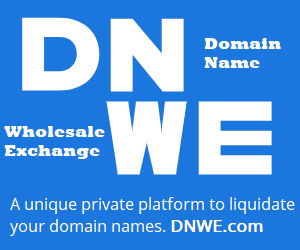Everyone has a different method to finding domain names. There are tens of thousands of names to look through every single day and everyone has a method of scanning through. I don’t follow the Mike Mann method of buying all of them and instead look for a few each day that fit my criteria. Here is my exact method of going through the lists and I do it in this exact order. I use Dropday as my tool but there are many tools out there that will do the same thing.
Age: I go through the list and sort by age. Age doesn’t necessarily make a good name but its a great place to start. Plain and simple, better names were taken earlier, thereby raising the chances of finding a good domain in the older section. I work the list all the way up to 2002. If there aren’t a lot I may go through a few more years
Searches: After I go through the age section and pick out the names, I then sort by searches. All the tools tend to be a little off the real amount of searches but its a good start. 95% of them are backwards terms like oysterfresh or general words that make no sense together but trigger the search numbers. I will find a few after breaking down the names in this category
Number of Ads: Not all tools have this but I like to see what names would have ads on them. Ads means interest. Interest means a higher chance of a sale. This section tends to have a lot of long tail names which I don’t specialize in so I usually find one or two good ones per week
Number of Bids: My next step is to go to the auction houses themselves and see which names have bids. I look through every single name that has a bid and see if there are any I missed. This is the main reason you shouldn’t bid until the very last minute. You attract people like me when you bid.
The order which I search. I always start with dot com and in this order. Namejet, Godaddy, Snapnames, 4.cn, and every once in a while Sedo. I then go to dot net, dot org, and then I filter all the rest by number of searches because the dates are irrelevant for the rest of the tlds. It takes a pretty interesting name to get me to buy a not dot com. I only buy PR domains that are garden related because otherwise I have no use for them. I don’t really look at the traffic because I don’t use the traffic and also don’t believe 99% of the traffic stats the tools and auction houses supply.
I tend to have a very specific type of name that I search for. It has to have a certain amount of all the above. I can’t go into too much detail because the less amount of people that want my names the better but it does have to have the following
1. Age
2. No more than two words
3. Easy to say and spell
4. Be words that everyone knows
5. Comprised of Short words
6. Be liquid
Being liquid is my proprietary bit of info. I have developed a pretty good sense of what I can sell for a profit. There are plenty of great names that I skip over and can make an investor good money but I have my own method and stick to names I know I can sell. Many of domains are for holding will only move if I get an offer for good money but most of my daily work is looking for names to turn and generate a profit. What I pay for a domain is of no concern as long as I can sell it for more.
I spend 1.5 to 2 hours every night looking though lists and personally know dozens of others that do the same. Fortunately I still seem to find a few solid domains every week using this method.


you are working too hard… just develop a white marigold in your nursery and you will be way better off.
You seem to be doing exactly what I do, except better.
Too bad that you are giving away your trade secrets like that for free.
I would say not wise!
But hey, it’s your blog.
Savio,
I wouldn’t consider that trade secrets . Pretty common knowledge
I found the Dropday search numbers to be way off most of the time, what are alternative tools that let you scan dropping names by search, cpc etc.?
George,
If I really like it I go straight to Adwords to check out the real numbers
Good info Shane. I must say our processes are nothing alike which just goes to show there is more than one way to skin a cat and still get a good result.
Although the process is different, I use many of the same metrics that you do. One more helpful one that you might use but didn’t mention is “registered in other extensions”
If a particular term is registered in 3 or more extensions, it could be a sign that there’s something worth looking into. It’s not a hard rule though. Many crappy terms are registered in multiple extensions.
Thanks again for your insight.
Great post! Would really love to see your insight into the other half of the equation you mention…selling